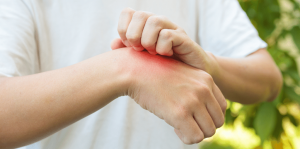
Plants are living things having the same goals as others on this planet. They want to survive and propagate. Different species developed their ways to protect themselves from attacks or being eaten. A poison ivy plant has developed toxins that deter animals and people from disturbing it. Coming into contact with it can cause rashes and blisters on your skin.
Poison ivy is common in the United States, found in almost every state except Alaska and Hawaii. They resemble shrubs and weeds growing low on the ground. Another type of poison ivy can climb up other plants and fences, resembling a vine. Both features stem that have three leaves that change color depending on the season.
The Poison Ivy Symptoms from Exposure
When your bare skin comes into contact with poison ivy, you will develop a rash which is the main symptom. That is known as contact dermatitis. The effect can vary from person to person. Some experience mild rashes, while other cases are more severe.
It can take a day or two after exposure for the rash to appear, it will not happen immediately. You will notice redness on the affected skin and some swelling. Blisters can form, which makes it itchy and painful.
No matter how itchy it gets, do not scratch the blisters. It can damage your skin, and bacteria get inside, leading to an infection. You can use oral medication or topical ointment for it.
How You Can Be Affected by Urushiol
The dangerous part of poison ivy is urushiol. That is the toxin responsible for the rashes you experience after coming into contact with it.
Urushiol oil can get on you when:
- You touch the plant directly with your skin.
- You touch clothing previously exposed to the plant and carry the oil.
- If you touch and use gardening tools used on the plant and oil.
- Touching the fur of your pet exposed to poison ivy.
- Exposure to smoke when burning poison ivy plants.
Diagnosing Poison Ivy
A doctor will determine if you have a poison ivy rash by examining it and reviewing your current symptoms to ensure that it was not caused by something else.

3 Ways to Prevent Poison Ivy
Knowledge is your best defense against exposure to poison ivy. Learn what it looks like and try to avoid it if you can.
If you do have to deal with poison ivy:
- Wear protective clothing when working in the garden. Ideally, use long-sleeve shirts, pants, and gloves. Wash them properly afterward.
- Clean all your tools after you garden or deal with poison ivy.
- If your pets come into contact with the plant, wash them. While the oil does not affect them, they can spread it to you.
When to go to Riverview Health Emergency Room & Urgent Care for Poison Ivy
Most cases of poison ivy exposure and rash go away naturally in a few weeks. The blisters will start to dry up and fade after about a week. However, severe cases of poison ivy rash need proper medical attention. The first sign is if the rash covers a lot of your body. You should also be careful if the rashes cover sensitive parts like your eyes, mouth, and genital area. Pus coming out of the rashes is a bad sign, too. A fever is also a common symptom of severe cases. The most dangerous is if you have a difficult time breathing after exposure to poison ivy.
When you experience these symptoms, you need to consult with a medical professional immediately.

Riverview Health Emergency Room & Urgent Care is the only health system in Hamilton County offering ER and urgent care services under one roof. Unlike most ER or urgent care centers, patients are only billed for the level of services they need. The ER is open 24 hours a day, seven days a week. The urgent care center is open from 7 a.m. to 8 p.m. daily. No appointments are not necessary for in-person visits; however, pre-registration is available.
Riverview Health Emergency Room Urgent Care has five convenient locations:
- Riverview Health Emergency Room & Urgent Care Carmel is located at 14585 Hazel Dell Pkwy., Carmel, IN 46033, and may be reached at 317.406.4280.
- Riverview Health Emergency Room & Urgent Care Fishers is located at 9690 E. 116th St., Fishers, IN 46037, and may be reached at 317.406.4585.
- Riverview Health Emergency Room & Urgent Care West Carmel/Zionsville is located at 10830 N. Michigan Rd., Zionsville, IN 46077, and may be reached at 317.406.4713.
- Riverview Health Westfield Hospital is located at 17600 Shamrock Blvd, Westfield, IN 46074, and may be reached at 317.214.5555.
- Riverview Health Noblesville Hospital is located at 395 Westfield Road, Noblesville, IN 46060.




